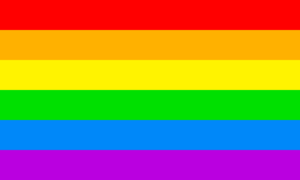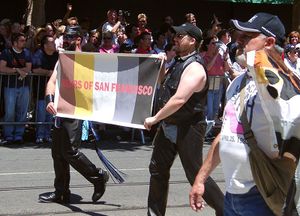Sexuality and gender identity-based cultures
Sexuality and gender identity-based cultures are subcultures and communities composed of persons who have shared experiences, background, or interests due to a common sexual or gender identity. Among the first to argue that members of sexual minorities can constitute cultural minorities as well as being just individuals were Adolf Brand, Magnus Hirschfeld and Leontine Sagan in Germany. These pioneers were followed later in the United States by the Mattachine Society and the Daughters of Bilitis.
Not all persons of various sexual preferences and gender identify by or affiliate with a sexuality or gender subculture. Reasons can include geographic distance, unawareness of the subculture's existence, fear of social stigma, or personal preference to remain unidentified with sexuality or gender based subcultures or communities. Micheal Rubio has suggested that the identities defined by the Western heterosexualised cultures, which are based on sexuality, have serious flaws, and since often no space for mainstream men to discuss these flaws of gender and sexuality exists, they just reject these identity in large numbers, often along with disowning their sexual needs that may subject them to be classified under what they may consider misclassified sexual identities.
LGBT culture
 Main article: LGBT culture
Main article: LGBT culture


LGBT culture is the common culture shared by lesbian, gay, bisexual and transgender people. It is sometimes referred to as "gay culture" or "queer culture", but those terms can also be specific to gay men's culture.
LGBT culture varies widely by geography and the identity of the participants. Elements often identified as being common to the culture of gays, lesbians, bisexuals, and transgendered people include:
- The work of famous gay, lesbian, bisexual and transgendered people. This may include:
- Present-day LGBT artists and political figures;
- Historical figures who have been identified as LGBT. It has often been questioned whether it is appropriate to identify historical figures using modern terms for sexual identity (see History of sexuality). However, many LGBT people feel a kinship towards these people and their work, especially to the extent that it deals with same-sex attraction or gender identity.
- An understanding of the history of LGBT political movements.
- An ironic appreciation of things linked by stereotype to LGBT people.
- Figures and identities that are present in the LGBT community and LGBT culture, this could include the gay village, drag kings and queens, Pride, and the rainbow flag.
In some cities, especially in North America, gay men and lesbians tend to live in certain neighbourhoods.
LGBT communities organize a number of events to celebrate their culture, such as Pride parades, the Gay Games and Southern Decadence.
There is some debate among LGBT people about whether an LGBT culture really exists, and whether it is worthwhile.
Polyamory
The polyamorous community is another sexual minority with an associated culture.
Fetish-based cultures
 Main article: Fetish subculture
Main article: Fetish subculture
[[Image:BDSM Company on Taiwan Pride 2005.jpg|thumb|BDSM activists in Taiwan The fetish subculture is a subculture that comprises people with a broad range of sexual fetishes and other paraphilias, who tend to be more tolerant of other fetishists than the general community, even if they do not share the other person's specific fetish. Alternative terms for the fetish subculture include fetish scene and fetish community.
The most common paraphilias seen in the fetish subculture are BDSM, leather fetishism and rubber fetishism. The fetish community is also generally more accepting of homosexuality, bisexuality, nonmonogamys and cross-dressing than general society.
The fetish subculture supports a strong nightclub scene, in the form of fetish clubs.
Influence on mainstream culture
Sexual minority cultures frequently and consistently influence straight culture. Yale sociology professor Joshua Gamson argues that the tabloid talk show genre, popularized by Oprah Winfrey in the 1980s provided much needed, high impact media visibility for sexual minorities and did more to make gay culture mainstream than any other development of the 20th century. Slang frequently originates in subcultures, including sexual minority subcultures, which becomes part of the larger vernacular including words associated with descriptions specific to sexual minorities or not.
Madonna is one of many artists who have borrowed from sexual minority cultures, including her appropriation of vogueing. Recently, the television series Queer Eye for the Straight Guy depicts straight men being given fashion make-overs or decorating tips from gay men.
Non-Western cultures
In 2005, Thai film Rainbow Boys, depicting a contemporary gay relationship and produced by Vitaya Saeng-aroon, saw a limited-release screening. Vitaya also produced the comedy-drama Club M2, set in a gay sauna.[1]
Another 2007 film, Bangkok Love Story, directed by Poj Arnon, was critically hailed as a departure from the stereotyped view of homosexuals as transvestites and transsexuals. Gay Thai independent film producer Vitaya Saeng-aroon praised the film: director Poj Arnon was "brave enough to shake society up," he said.[1]
See also
- Bisexual community
- LGBT subculture
- LGBT history
- Queer
- Separatist feminism
- Sexual orientation
- Girlfags and guydykes
- Non-westernized concepts of male sexuality
Further reading
- Cante, Richard C. (March 2009). Gay Men and the Forms of Contemporary US Culture. Ashgate Publishing.
- De La Torre, Miguel A. (2009). Out of the Shadows, into the Light: Christianity and Homosexuality. Chalice Press.
References
- ↑ 1.0 1.1 The real pride in being gay, The Nation (Thailand); retrieved 2007-11-17
External links
Sexual identity symbols on Wikimedia Commons
- The Androphile Project Extensive resource of gay and bisexual history
- The Gay, Lesbian, Bisexual, Transgender Historical Society
- Catch Fire Blog dedicated to queer culture / queer social practice
| Related Sexual Identity topics | |
|---|---|
| Gender | |
| Orientations | |
| Third genders | |
| Other | |
Chat rooms • What links here • Copyright info • Contact information • Category:Root